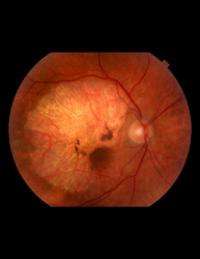Vision loss slowed by encapsulated cell therapy

(PhysOrg.com) -- A phase 2 clinical trial for the treatment of a severe form of age-related macular degeneration called geographic atrophy (GA) has become the first study to show the benefit of a therapy to slow the progression of vision loss for this disease. The results highlight the benefit of the use of a neurotrophic factor to treat GA and provide hope to nearly one million Americans suffering from GA.
The multi-center research team, including Dr. Kang Zhang of the University of California, San Diego, Shiley Eye Center, the lead author of the paper and one of the leading investigators in the study, found that long-term delivery of ciliary neurotrophic factor (CNTF) served to re-nourish the retina and stop or slow the loss of visual acuity caused by the disorder. The results were recently published online in the Proceedings of the National Academy of Sciences (PNAS).
According to Zhang — professor of ophthalmology and human genetics at the UCSD School of Medicine and director of UCSD's Institute of Genomic Medicine — there is currently no effective treatment for dry AMD or GA, though there is a very big need. "This could open the door to long-term treatment of dry AMD, using a simple surgical procedure."
Age-related macular degeneration, or AMD, is a leading cause of vision loss in Americans age 60 and older. It is a disease that causes cells in the macula — the part of the eye that allows us to see in fine detail - to die. There are two forms of the disorder, wet and dry AMD. GA is considered the end stage of dry AMD, where central vision is lost.
According to the National Eye Institute, wet AMD occurs when abnormal blood vessels behind the retina start to grow under the macula. These new blood vessels tend to be very fragile and often leak blood and fluid. The blood and fluid raise the macula from its normal place at the back of the eye, resulting in rapid loss of central version. There is currently a very effective therapy for wet AMD. Dry AMD occurs when the light-sensitive cells in the macula slowly break down, gradually blurring central vision in the affected eye.
In the trial, high-dose CNTF was delivered to 27 GA patients using encapsulated cell therapy (ECT). Another 24 patients received either a sham surgery (12) or a low-dose of CNTF (12). CNTF affects survival and differentiation of cells in the nervous system, including retinal cells. CNTF has been shown to retard the loss of photoreceptor cells in many animal models of retinal degeneration.
The ECT utilized a capsule that contains genetically engineered cells to continuously produce CNTF over a 12-month period. The CNTF-secreting capsule was implanted in the back of the study subject's eye. The implant allows the CNTF molecules to diffuse into the eye tissue, while keeping out antibodies and immune cells that would attack and destroy the CNTF-producing cells.
There was a statistically significant difference in the change of the total macular volume in the eyes of study participants at the 12-month point, versus baseline in the high-dose group, according to Zhang. "In addition, all but one of the patients in the high dose group, or 96.3 percent, maintained stabilized vision, compared to only 75% of the patients in the sham-treatment group."
The patients treated with a high dose of CNTF also showed an increase in retinal thickness as early as four months after implant, an increase that correlated to the stabilization of vision.















